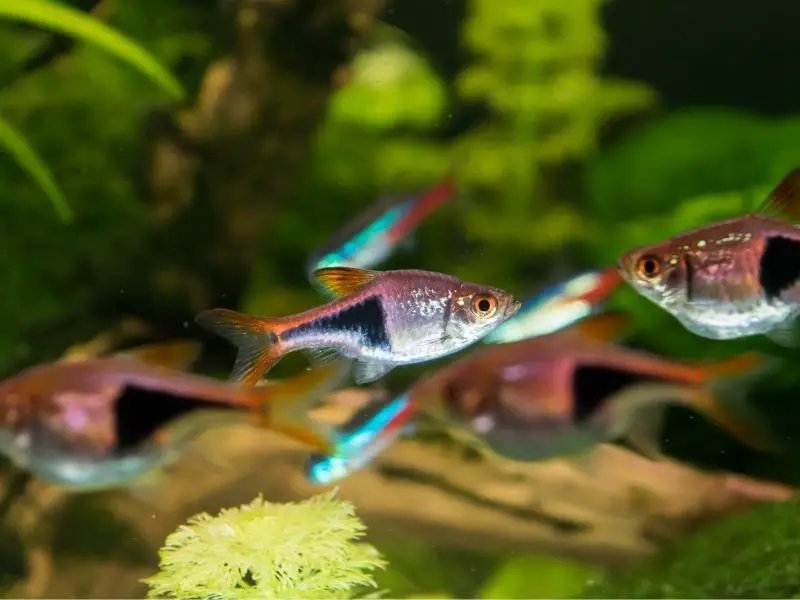
Rasboras are peaceful, social fish that love company—imagine them as the friendly neighbors of the aquarium world. They usually swim in schools, creating a mesmerizing dance as they glide through the water. Caring for them involves more than just feeding; you’ll want to establish the right environment, understand their dietary needs, and be mindful of their health. Let’s dive into the essential steps to make sure your rasboras flourish in their new home.
Understanding Rasbora Species
Rasboras come in several species, each with unique traits. The most popular ones include the Harlequin Rasbora, Lambchop Rasbora, and the Galaxy Rasbora. The Harlequin Rasbora is known for its striking copper color and triangular black patch, while the Galaxy Rasbora displays a stunning pattern of starry spots. Each type has its charm, but they all share similar care requirements that make them great choices for beginners.
Understanding the specific species you choose will help you cater to their individual needs. For instance, the Harlequin Rasbora thrives well in a well-planted tank with gentle water flow. In contrast, the Galaxy Rasbora prefers slightly cooler water. Always take note of their optimal temperature and pH levels so you can keep your tank in harmony.
Choosing the right rasbora isn’t just about looks. It’s also about compatibility. These fish do best in groups of six or more and prefer to live among their kind. When considering your tank mates, think about other peaceful species that share similar environmental needs.
Setting Up the Perfect Habitat
Creating a suitable environment for your rasboras is crucial. Start with a minimum tank size of 10 gallons. A larger tank not only gives your fish more swimming space but also helps maintain stable water conditions. Rasboras appreciate being in schools, so more room means they can express their natural behaviors without feeling cramped.
Your aquarium should be adorned with plenty of plants, rocks, and hiding spots. Think of it as designing a cozy neighborhood for your fish. Visual barriers like plants can provide cover and help reduce stress. Floating plants, like Java Moss, can offer shade, while tall plants can give them areas to dart around.
In terms of water conditions, rasboras prefer a pH level of 6.5 to 7.5, with a temperature range of 72°F to 82°F. A heater and quality filtration system are essential to maintain the right environment. Also, consider using a dechlorinator for tap water, as chlorine can be harmful to your fish.
Feeding Your Rasboras
Feeding rasboras might seem straightforward, but it’s an essential part of keeping them healthy. These fish are omnivores, which means they enjoy both plant and animal-based food. High-quality flake food is a great staple, but you should also mix it up with frozen or live food like brine shrimp, daphnia, or small insects.
You’ll want to feed them small portions 2–3 times a day. Keep an eye on how much they eat; uneaten food can pollute the water. It’s often best to feed only what they can consume in a few minutes. If you’re worried about their diet, consider using a spirulina supplement or high-quality pellets that can help enhance their colors.
Sometimes, you might notice your rasboras being shy around feeding time. Don’t worry! They usually warm up after a few days. Just be patient and consistent with their feeding routine.
Maintaining Tank Conditions
Keeping your tank clean is critical to your rasboras’ health. Regular maintenance helps prevent diseases and keeps the water quality high. Aim to change about 10-15% of the water weekly. This helps remove harmful toxins while keeping beneficial bacteria thriving.
When you change the water, use a siphon to clean waste and uneaten food from the substrate. Be sure to check your filter regularly, too—clean it as needed but avoid over-cleaning, as this can disrupt the beneficial bacteria that keep the tank balanced.
Additionally, consider investing in a water testing kit to keep tabs on ammonia, nitrite, and nitrate levels. Rasboras are sensitive to poor water conditions, and establishing a routine for testing will help you catch problems before they escalate.
Understanding Common Health Issues
Rasboras are generally hardy fish, but like any pet, they can face health challenges. Ich, or white spot disease, is one of the most common issues. It appears as white spots on their bodies and fins. The good news is that it’s treatable with over-the-counter medications available at pet stores.
Other potential issues include fin rot, often caused by poor water quality or injury, and swim bladder disease, which affects their buoyancy. To combat these, ensure you maintain excellent water conditions and that your fish aren’t stressed from overcrowding or aggressive tank mates.
Being observant can really help keep your rasboras healthy. Look out for changes in behavior, such as lethargy, loss of appetite, or unusual swimming patterns. Early detection is key to resolving health problems effectively.
Breeding Rasboras
If you’re feeling adventurous and your setup is strong, you might consider breeding your rasboras. They can breed relatively easily in a community tank, but a separate breeding tank provides a better chance for fry survival. A gentle sponge filter and plenty of fine-leaved plants for the eggs to attach to are essential.
When rasboras breed, the male will chase the female, often leading her to the plants where she’ll lay eggs. After spawning, remove the adults, as they may eat the eggs. The fry are tiny and need infusoria or finely crushed flakes to start their feeding journey. With patience and proper care, you could find yourself raising a new generation of these charming fish!
In conclusion, caring for a rasbora in your freshwater aquarium can be incredibly rewarding. They’re lively, social creatures that can brighten any tank. By setting up the right environment, feeding them well, maintaining water quality, and keeping an eye on their health, you’ll create a thriving habitat for your rasboras to flourish. Remember, each step you take in their care brings you closer to enjoying the beauty of these remarkable little fish. Happy fish-keeping!

